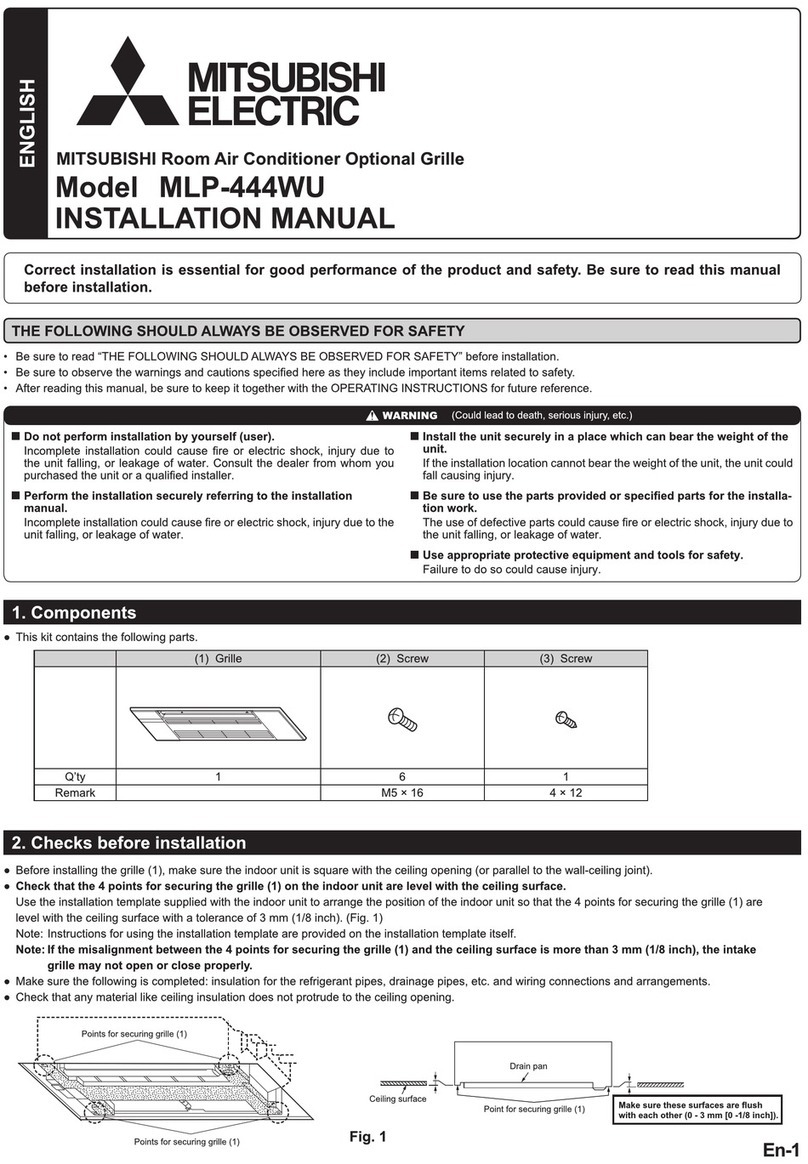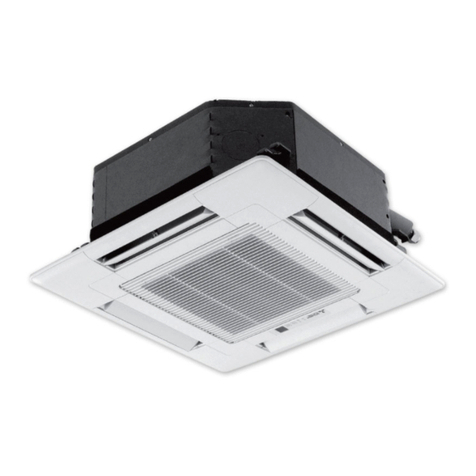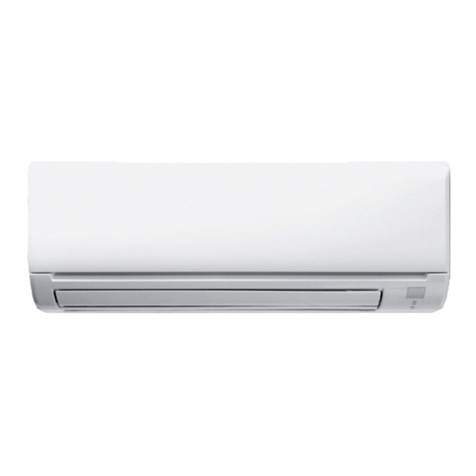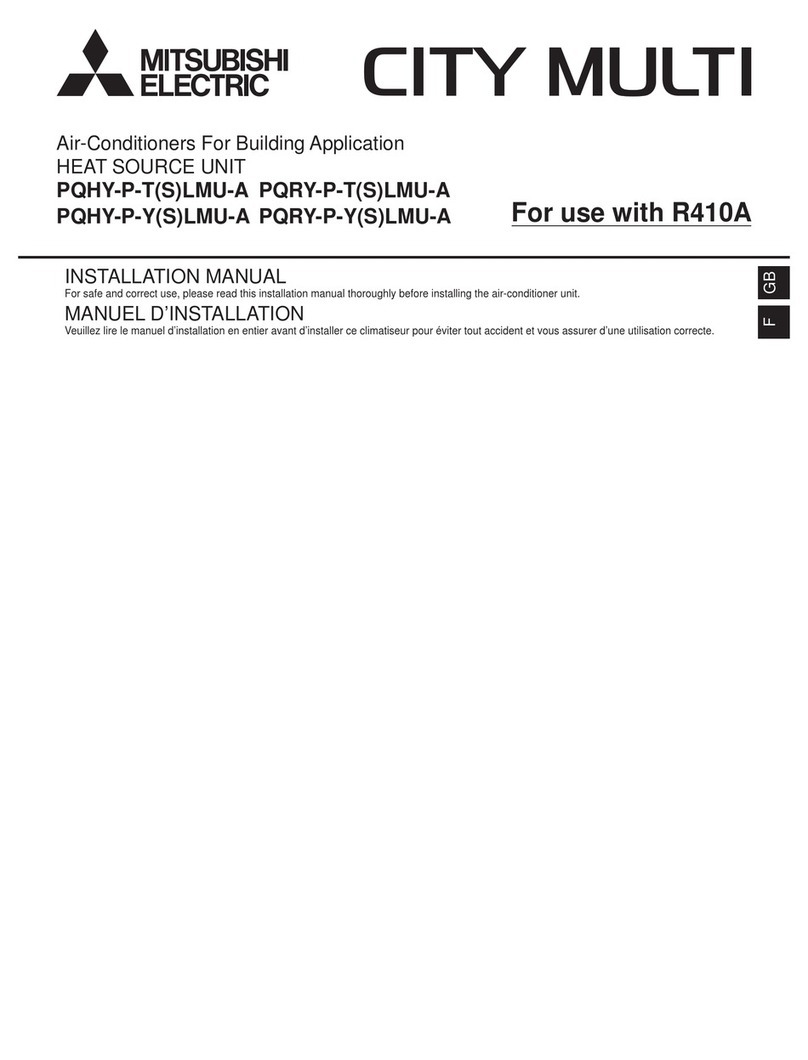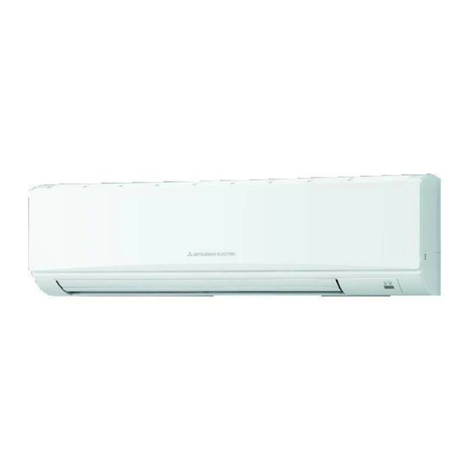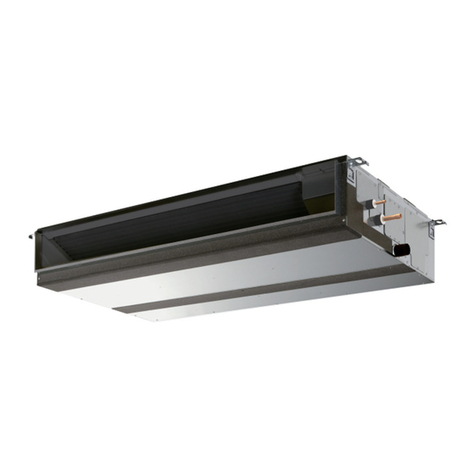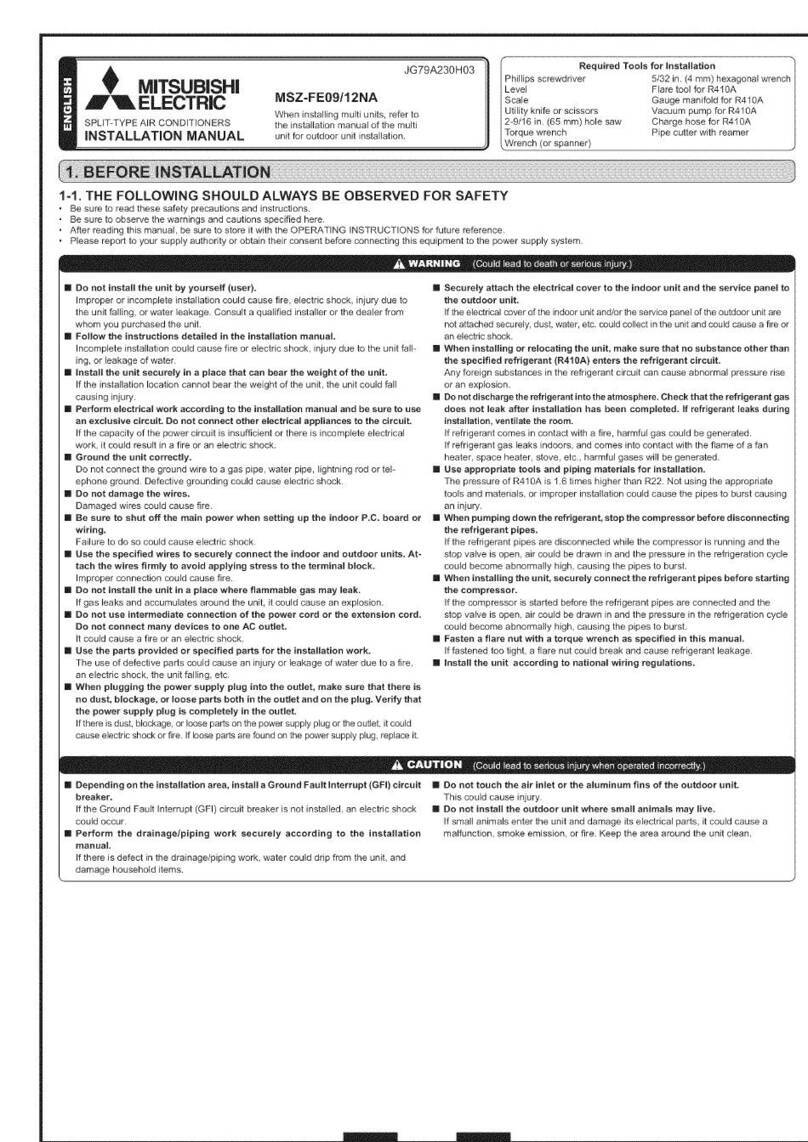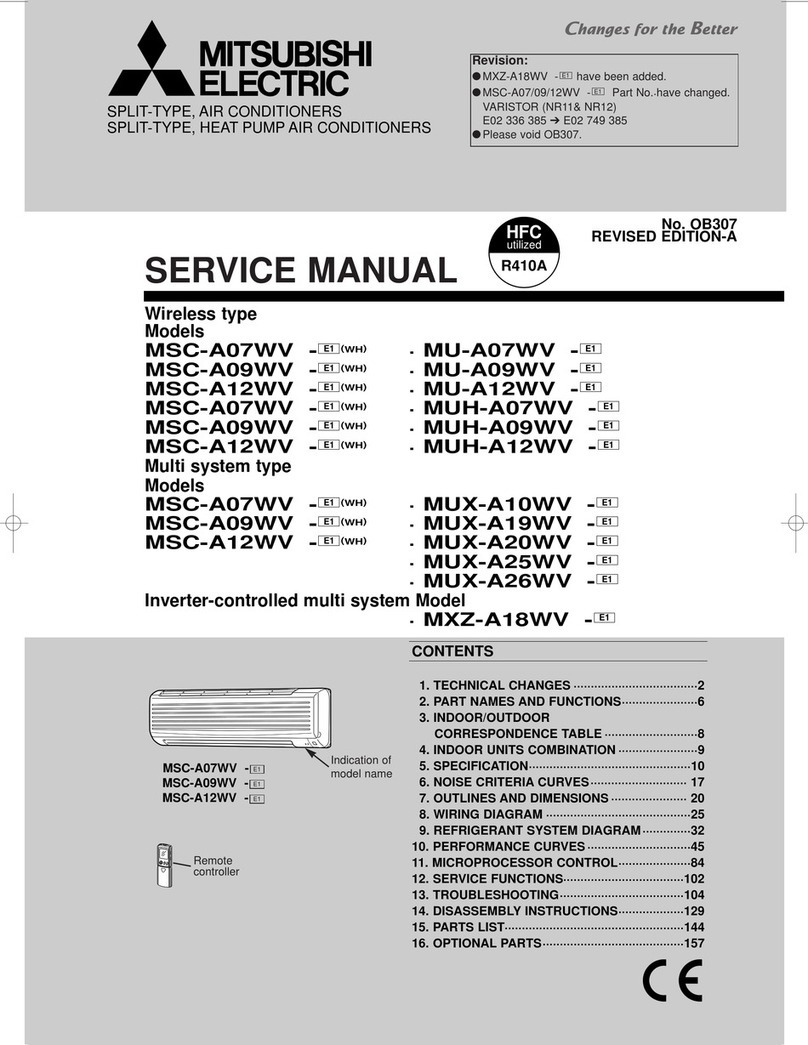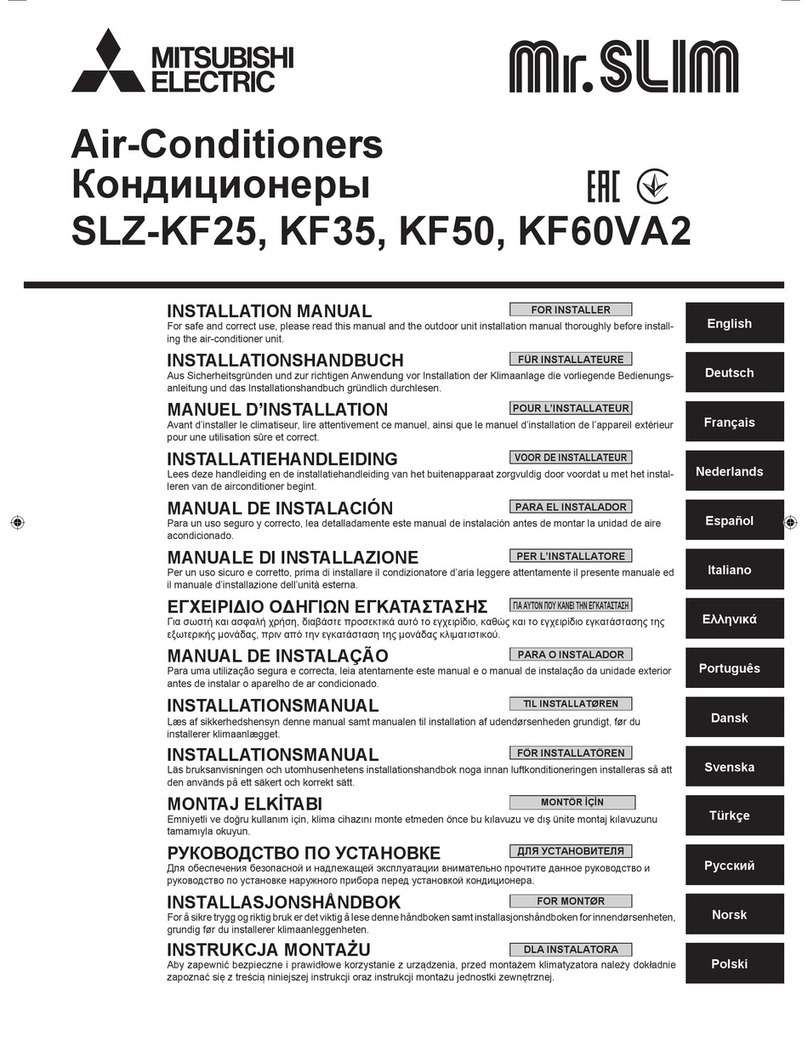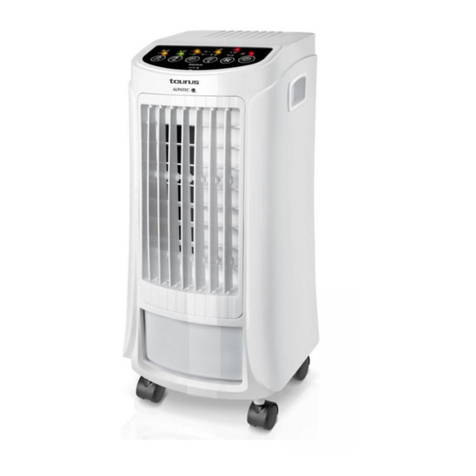
En-1
CONTENTS
1. BEFORE INSTALLATION....................................1
2. INDOOR UNIT INSTALLATION...........................3
3. OUTDOOR UNIT INSTALLATION.......................6
4. PURGING PROCEDURES, LEAK TEST,AND
TEST RUN...........................................................7
5. PUMPING DOWN................................................7
1. BEFORE INSTALLATION
1-1. THE FOLLOWING SHOULD ALWAYS BE OBSERVED FOR SAFETY
• Be sure to read “THE FOLLOWING SHOULD ALWAYS BE OBSERVED FOR SAFETY” before installing the air conditioner.
• Besuretoobservethewarningsandcautionsspeciedhereastheyincludeimportantitemsrelatedtosafety.
• After reading this manual, be sure to keep it together with the OPERATING INSTRUCTIONS for future reference.
1-2. SELECTING THE INSTALLATION LOCATION
CAUTION
(Couldleadtoseriousinjuryinparticularenvironmentswhenoperatedincorrectly.)
Required Tools for Installation
Phillips screwdriver
Level
Scale
Utilityknifeorscissors
25, 35 class 65 mm/50
class 75 mm hole saw
Torque wrench
Wrench(orspanner)
4 mm hexagonal wrench
Flare tool for R410A
Gauge manifold for R410A
Vacuum pump for R410A
Charge hose for R410A
Pipe cutter with reamer
nDo not install the unit by yourself (user).
Incomplete installation could cause fire, electric
shock,injuryduetotheunitfalling,orleakageof
water.Consultthedealerfromwhomyoupurchased
theunitoraqualiedinstaller.
nPerform the installation securely referring to the
installation manual.
Incomplete installation could cause fire, electric
shock,injuryduetotheunitfalling,orleakageof
water.
nWhen installing the unit, use appropriate protec-
tive equipment and tools for safety.
Failuretodosocouldcauseinjury.
nInstall the unit securely in a place which can
bear the weight of the unit.
If the installation location cannot bear the weight of
theunit,theunitcouldfallcausinginjury.
n Electrical work should be performed by a quali-
ed, experienced electrician, according to the
installation manual. Be sure to use an exclusive
circuit. Do not connect other electrical appli-
ances to the circuit.
Ifthecapacity of the power circuitisinsufcient or
there is incomplete electrical work, it could result in
areoranelectricshock.
nEarth the unit correctly.
Do not connect the earth to a gas pipe, water pipe,
lightning rod or telephone earth. Defective earthing
could cause electric shock.
n Do not damage the wires by applying excessive
pressure with parts or screws.
Damagedwirescouldcausereorelectricshock.
n Be sure to cut off the main power in case of set-
ting up the indoor P.C. board or wiring works.
Failure to do so could cause electric shock.
n Use the specied wires to connect the indoor
and outdoor units securely and attach the wires
rmly to the terminal block connecting sections
so the stress of the wires is not applied to the
sections. Do not extend the wires, or use inter-
mediate connection.
Incomplete connecting and securing could cause
re.
n Do not install the unit in a place where inam-
mable gas may leak.
If gas leaks and accumulates in the area around the
unit, it could cause an explosion.
nDo not use intermediate connection of the
power cord or the extension cord and do not
connect many devices to one AC outlet.
Itcouldcauseareoranelectricshockduetode-
fective contact, defective insulation, exceeding the
permissible current, etc.
n Be sure to use the parts provided or specied
parts for the installation work.
Theuseofdefectivepartscouldcauseaninjuryor
leakageofwaterduetoare,anelectricshock,theunit
falling, etc.
n When plugging the power supply plug into the
outlet, make sure that there is no dust, clogging,
or loose parts in both the outlet and the plug. Make
sure that the power supply plug is pushed com-
pletely into the outlet.
If there is dust, clogging, or loose parts on the power
supplyplugortheoutlet,itcouldcauseelectricshock
orre.Ifloosepartsarefoundonthepowersupply
plug, replace it.
n Attach the electrical cover to the indoor unit and
the service panel to the outdoor unit securely.
If the electrical cover of the indoor unit and/or the serv-
icepaneloftheoutdoorunitarenotattachedsecurely,
itcouldresultinareoranelectricshockduetodust,
water, etc.
n When installing, relocating, or servicing the unit,
make sure that no substance other than the
specied refrigerant (R410A) enters the refriger-
ant circuit.
Anypresenceofforeignsubstancesuchasaircan
causeabnormalpressureriseandmayresultin
explosionorinjury.Theuseofanyrefrigerantother
thanthatspecifiedforthesystemwillcauseme-
chanical failure, system malfunction, or unit break-
down. In the worst case, this could lead to a serious
impedimenttosecuringproductsafety.
n Do not discharge the refrigerant into the atmos-
phere. If refrigerant leaks during installation, venti-
late the room.
Ifrefrigerantcomesincontactwithare,harmful
gas could be generated.
n Check that the refrigerant gas does not leak
after installation has been completed.
If refrigerant gas leaks indoors, and comes into
contactwiththeameofafanheater,spaceheater,
stove, etc., harmful substances will be generated.
n Use appropriate tools and piping materials for
installation.
The pressure of R410A is 1.6 times more than R22.
Not using appropriate tools or materials and incom-
plete installation could cause the pipes to burst or
injury.
n When pumping down the refrigerant, stop the
compressor before disconnecting the refriger-
ant pipes.
If the refrigerant pipes are disconnected while the
compressor is running and the stop valve is open,
air could be drawn in and the pressure in the refrig-
erationcyclecouldbecomeabnormallyhigh.This
couldcausethepipestoburstorinjury.
n When installing the unit, securely connect the
refrigerant pipes before starting the compres-
sor.
If the compressor is started before the refrigerant
pipes are connected and when the stop valve is
open, air could be drawn in and the pressure in the
refrigerationcyclecouldbecomeabnormallyhigh.
Thiscouldcausethepipestoburstorinjury.
n Fasten a are nut with a torque wrench as speci-
ed in this manual.
Iffastenedtootight, a arenutmaybreakafter a
long period and cause refrigerant leakage.
n The unit shall be installed in accordance with
national wiring regulations.
nInstall an earth leakage breaker depending on
the installation place.
If an earth leakage breaker is not installed, it could
cause electric shock.
nPerform the drainage/piping work securely ac-
cording to the installation manual.
If there is defect in the drainage/piping work, water
could drop from the unit, soaking and damaging
household goods.
n Do not touch the air inlet or the aluminum ns
of the outdoor unit.
Thiscouldcauseinjury.
nDo not install the outdoor unit where small ani-
mals may live.
If small animals enter and touch the electric parts
inside the unit, it could cause a malfunction, smoke
emission,orre.Also,adviseusertokeepthearea
around the unit clean.
WARNING (Couldleadtodeath,seriousinjury,etc.)
ENGLISH
INDOOR UNIT
• Whereairowisnotblocked.
• Where air spreads over the entire room.
• Rigid wall without vibration.
• Where it is not exposed to direct sunshine. Do not
expose to direct sunshine also during the period fol-
lowing unpacking to before use.
• Whereeasilydrained.
• At a distance 1 m or more away from your TV and
radio. Operation of the air conditioner may interfere
with radio or TV reception. An amplier may be re-
quired for the affected device.
• In a place as far away as possible from uorescent
and incandescent lights (so the infrared remote con-
trolcanoperatetheairconditionernormally).
• Where the air filter can be removed and replaced
easily.
REMOTE CONTROLLER
• Whereitiseasytooperateandeasilyvisible.
• Where children cannot touch it.
• Select the position where the indoor unit can receive
thesignalfromtheremotecontrollerproperly.Check
thatsignalsfromtheremotecontrolleraresurelyre-
ceivedbytheindoorunitfromthatposition(‘beep’or
‘beepbeep’receivingtonesounds).Afterthat,attach
remote controller holder to a pillar or wall and install
wireless remote controller.
Note:
Inroomswhereinvertertypefluorescentlampsare
used,thesignalfromthewirelessremotecontrollermay
not be received.
OUTDOOR UNIT
• Where it is not exposed to strong wind.
• Whereairowisgoodanddustless.
• Where rain or direct sunlight can be avoided as much
as possible.
• Whereneighboursarenotannoyedbyoperation
sound or hot air.
• Where rigid wall or support is available to prevent the
increase of operation sound or vibration.
• Where there is no risk of combustible gas leakage.
• When installing the unit at a high level, be sure to
secure the unit legs.
• Whereitisatleast3mawayfromtheantennaof
TVsetorradio.Operationoftheairconditionermay
interfere with radio or TV reception in areas where re-
ceptionisweak.Anampliermayberequiredforthe
affected device.
• Installtheunithorizontally.
• Pleaseinstallitinanareanotaffectedbysnowfallor
blowingsnow. In areas withheavysnow, please in-
stallacanopy,apedestaland/orsomebafeboards.
Note:
It is advisable to make a piping loop near outdoor unit
so as to reduce vibration transmitted from there.
Note:
When operating the air conditioner in low outside tem-
perature, be sure to follow the instructions described
below.
• Never install the outdoor unit in a place where
its air inlet/outlet side may be exposed directly to
wind.
• To prevent exposure to wind, install the outdoor
unit with its air inlet side facing the wall.
• To prevent exposure to wind, it is recommended
toinstallabafeboardontheairoutletsideofthe
outdoor unit.
Avoid the following places for installation where air
conditioner trouble is liable to occur.
• Whereammablegascouldleak.
• Where there is much machine oil.
• Whereoilissplashedorwheretheareaislled
withoilysmoke(suchascookingareasandfac-
tories, in which the properties of plastic could be
changedanddamaged).
• Saltyplacessuchastheseaside.
• Where sulfide gas is generated such as a hot
spring.
• Wherethereishigh-frequencyorwirelessequip-
ment.
• Where there is emission of high levels of VOCs,
includingphthalatecompounds,formaldehyde,
etc.,whichmaycausechemicalcracking.
Model names are indicated in 1-3.
When installing multi units, refer to
the installation manual of the multi
unit for outdoor unit installation.
JG79A867H01_en.indd 1 2014/02/07 15:44:57

